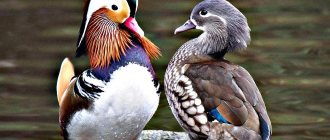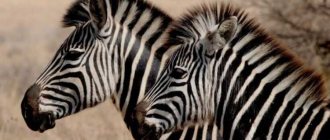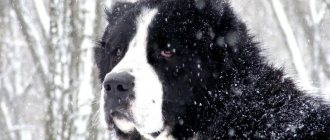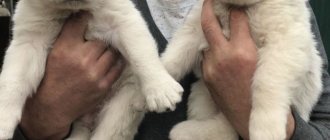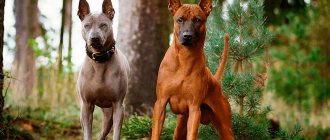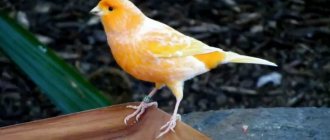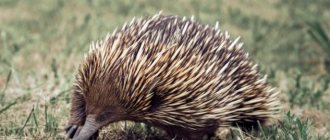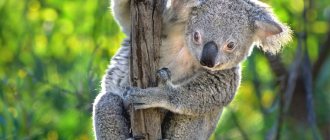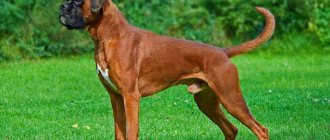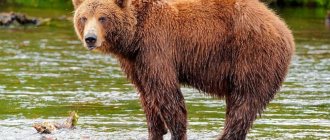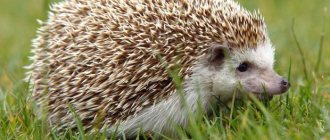- Wild animals
- >>
- Mammals
Many people, when they see this cute creature, exclaim: “What a wonderful little bear!” But the koala is not a bear at all; this animal cannot even be called a relative of bears. This animal belongs to the marsupials and has its own family of koalas, of which it is the only representative. A koala looks like a plush toy that you just want to hug.
Description, structure, characteristics
Although the koala is called a marsupial bear, or an Australian bear, due to some external similarity, it has nothing to do with real bears; the koala and the bear are not even distant relatives. The koala belongs to the family of marsupials, which is represented by three species: koalas themselves, wombats and kangaroos. The wombat is the closest relative of the koala.
The appearance of the koala is very unusual. Its fur is short and thick, usually gray, smoky in color, but there are koalas with brown shades. But her belly is always white.
The body length of the koala is 60-85 cm, with a weight of up to 14 kg.
The koala's eyes are small and blind, vision is not its greatest advantage, but the koala's weak vision is fully compensated by its excellent hearing and sense of smell. The koala's large ears are located at the edges of its head and are also covered with fur. The koala also has a large flattened black nose.
Koala teeth are ideal for eating plants; however, all marsupials, including wombats, these closest relatives of koalas, have a similar tooth structure.
And since koalas live mainly in trees, nature gave them tenacious front paws with long claws (promoting tenacity). Each koala's front paw has two double-phalangeal thumbs and three standard three-phalangeal toes. The hind legs are arranged differently - on the koala’s foot there is only one big toe, which is devoid of nails, and four ordinary toes. Thanks to their tenacious front paws, koalas easily cling to tree branches and in this position they dine, rest and even sleep.
Does a koala have a tail? Yes, there is, but only the koala's tail is so short that it is practically invisible under the fur.
Behavior
Koalas are mainly sedentary and nocturnal. They are slow and sleep up to 18 hours a day. Koalas spend almost all their time in trees, coming down to the ground only to move to another tree or lick the soil and gravel, which improve digestion. Koalas are primarily solitary animals and social behavior is unlikely outside the breeding season. However, small harems led by one male do occur.
History of the discovery of koalas
Interestingly, the discoverer of Australia, the famous English navigator James Cook, never discovered koalas, despite the fact that there were plenty of koalas at his landing site. Well, Captain Cook was just unlucky to meet them. And the first European to see these unique animals with his own eyes was the English naval officer Barallier. In 1820 he sent
the preserved body of a dead koala to the governor of New South Wales; a year later, a live koala was caught for the first time. Since then, this unique animal has become the subject of passion and research of many European zoologists.
Security measures
Due to the fact that most of the traditional habitats of these animals were destroyed, only scattered populations have survived today. About a hundred years ago, koalas were on the verge of extinction. The people who were attracted by the soft and expensive fur of these animals were to blame for this. In 1924 alone, over two million koala skins were exported from Australia.
Today, koalas are under special protection; their extermination is prohibited. Koalas are bred in zoos and nature reserves, restoring their populations.
Nutrition
What do koalas eat? All of them are herbivorous vegetarians, and their main source of food is shoots and
eucalyptus leaves. Interestingly, koalas have practically no food competitors, since eucalyptus leaves, which contain little protein and also contain hydrocyanic acid, are not interesting for other herbivores. But even among eucalyptus trees, not all leaves and shoots are suitable for food for koalas; thanks to their well-developed sense of smell, they are able to select the least toxic among them. In general, according to zoologists, koalas eat only 120 species of eucalyptus out of 800 found in nature.
A koala eats from 0.5 to 1.1 kg of leaves per day, and this is relatively little, but since all koalas are phlegmatic and inactive, this is enough for them. Also, sometimes they can eat ordinary soil, thus they compensate for the lack of certain minerals in the body.
As for the name of the koala - “non-drinker”, to some extent it is justified, since all marsupials consume very little moisture; koalas usually need morning dew that settles on the leaves and the moisture present in eucalyptus leaves to quench their thirst . But during periods of illness or drought, koalas can drink water from various fresh sources, as all other animals do.
There are fingerprints
0
We all know about human-monkey matches, human-pig matches, etc., but perhaps you haven't heard of human-koala matches before. Now you find out that an Australian resident and a person have similar fingerprints. Each animal has its own unique pattern on the “sole of the hand.” These cute marsupials are somewhat similar to humans - of course, they lag behind in terms of intelligence, and we have different food preferences. However, fingerprints are what unites us. If you look at them under a microscope, you will not find any differences... Moreover, in 1996, thanks to this discovery, scientists suggested that vortices and lines increase the tenacity of the limbs.
Lifestyle
All koalas are nocturnal; during the day they sleep peacefully on branches, and at night they climb these same branches in search of food. In general, these are very calm, good-natured, phlegmatic animals, leading a solitary, one might even say hermit, life. Koalas unite only for reproduction, and so they prefer to live separately, each koala has its own territory, and if the boundaries of this territory are violated by another koala, then the peacefulness of the koala can be replaced by aggressive behavior.
But koalas are usually friendly to people and are easily tamed. Now in Australia there are many koala nurseries where you can easily pet a koala, even pick it up.
Where does the koala live?
Photo: Koala in Australia
The koala is endemic to Australia and has its permanent residence exclusively on this continent; this animal is not found anywhere else. The animal has settled in the coastal zones of the south and east of Australia. In the last century, koalas were brought to the western part of the Australian continent and to the islands of Kunguru and Magnitny, located near Queensland. Magnetic Island is now considered the northernmost limit of koala habitat. A huge number of these marsupials were destroyed in southern Australia all in the same last century. People began to restore the number of koalas by bringing them from Victoria.
Currently, the koala habitat area is about a million square kilometers. Koalas live where dense eucalyptus forests grow. They prefer both mountain forests with a humid climate and semi-desert areas with small copses. The population density of animals depends on the availability of food resources on its territory. If in the southern part, where rainforests abound, it can reach eight individuals per hectare, then in the western semi-desert territory you can find one animal per hundred hectares.
Enemies in nature
In natural conditions, koalas have practically no enemies, since even wild dogs, dingoes, these Australian predators generally avoid koalas because of their bright eucalyptus scent. But human activity has had a very detrimental effect on their population, recently
Highways are increasingly cutting through the Australian eucalyptus forests, the patrimony of koalas, and often the clumsy and slow koalas die under the wheels of cars.
Population status
In the 19th century, after the active settlement of Australia by colonists, mass shooting and trapping of koalas began. Animals were killed to obtain thick, soft and water-repellent fur. In some years, exports of skins reached 2 million pieces. Commercial hunting was the main reason for the sharp decline in the population of animals, which almost became another endangered species.
Since the second decade of the 20th century, the Australian government has taken a number of measures to protect koalas. The creation of national parks and a complete ban on the destruction of animals made it possible to partially restore the species' numbers.
At the end of the last century, the international Australian Koala Foundation was opened. The main activities of the organization: studying and treating koalas, preserving their habitats, collecting information on the number of marsupials.
In addition to human extermination, factors influencing population sizes include deforestation of eucalyptus forests and the death of animals as a result of epizootics. The most common diseases among Australian bears are pneumonia, cystitis, and periostitis of the skull.
Currently, koalas are listed in the International Red Book with the status of “vulnerable species”.
HONEYBEATTER
Reproduction
The mating season for koalas begins in October and lasts until February. During this period, female koalas begin to select their love partners. The larger the male koala, and the louder he is able to scream, the more attractive he will be to females. It is also very interesting that among koalas there are many times fewer males than females, there are simply fewer of them born, and as a result, one male usually fertilizes from three to five females per season.
The pregnancy of a female koala lasts 30-35 days, after which a single cub is born; in very rare cases, twins can be born. Also, pregnancy in a female koala can only happen once every two years. Small koalas are born naked, hairless and at first are under the close care of their mother, drink breast milk and sit in a pouch like cubs
kangaroo.
Having matured a little, little koalas begin to climb onto the mother’s scruff, clinging to the fur. After a year, they become ready for adult life, but they remain close to their mother until they are two or three years old. Only after reaching sexual maturity, in the second or third year of life, do they leave their mother forever to become independent adult koalas.
Features of character and lifestyle
Photo: Koala Bear
The measured and monotonous lifestyle of koalas is directly related to the evergreen eucalyptus trees on which they spend most of their time. Rare dashes on the ground serve only to move from one tree to another. During the daytime, koalas are overcome by sound and restless sleep, which lasts from 18 to 20 hours.
Then (usually at night) dormice spend a couple of hours feeding. Koalas have an unusual and strange ability to freeze, like idols, and sit for many hours completely motionless. Apparently, at these moments they philosophize and reflect on their leisurely life, saturated with the eucalyptus smell.
The koala climbs trees quite deftly, clinging to trunks and branches with its clawed paws. Although the animals are slow and inhibited, when they sense a threat, they can quickly run away and then hide in the green crown. This animal can even cope with the water element if necessary. In addition, when frightened, the koala screams heart-rendingly in a low voice, although under normal conditions he is silent and modest.
Koalas live alone, each having their own territory. They do not favor randomly wandering competitors; males usually start a fight when they meet, especially during the mating season. Koalas have a sedentary lifestyle; they prefer not to leave their territories. In the wild, koalas live for about 12 years; in captivity they can live up to 20, although this is very rare.
Still, speaking about the character and disposition of these unusual creatures, it is worth noting that they are not as temperamental as many other animals, but very friendly, kind and trusting. It is easy to tame and become a true friend for a koala; the animal very quickly becomes attached to people and gives them its love and tenderness. Looking at the slowness and lethargy of koalas, you experience peace, and all worries and vanity fade into the background.
To summarize, here we can highlight the following features of the character and disposition of koalas:
- slowness;
- detachment;
- gullibility;
- good nature.
Keeping at home
Despite its peaceful nature, keeping a koala at home is not the best idea; more precisely, it is simply absolutely not possible due to the feeding habits of these animals. As we wrote above, koalas eat leaves and shoots of eucalyptus trees, but, unfortunately, they are not able to digest other food. But even among eucalyptus leaves, picky koalas eat only 120 varieties out of 800, and you won’t be able to determine exactly which leaves are suitable for koalas and which are not. For this reason, koalas can live exclusively in their natural territory in eucalyptus forests.
Common types
Despite some differences in animals living on different parts of the continent, they are all representatives of the same species, cinereus koala. Gray and brown koalas do not have genetic differences that would allow classification into different subspecies groups.
Individuals from different parts of the continent can have common offspring.
Moreover, what is good for some koalas is also good for others. Therefore, scientists involved in animal relocations give preference to areas where koalas already live, despite their external differences.
Interesting Facts
monkeys and of course humans.
Animal rescue
If it were for the inactive activities of animal activists, we would only know about the koala from schematic drawings in their textbooks. They managed not only to push through several laws to protect these animals, but also to win over patrons who are willing to donate money to save the “teddy bears.”
Interesting facts about ants209934.431
In Australia, parks and reserves were created, special hospitals for these animals were organized with the latest equipment and highly qualified veterinarians. This is not much, but it helps - about 4 thousand animals are saved per year. About twenty percent of animals that fall into the hands of doctors survive.
Life in captivity
As already mentioned, most koalas live on private property, the owners of which have nothing against such a neighborhood. People are often captivated by the appearance of these cute fluffy animals that look like teddy bears, and they tame them. Koalas, although they like to be alone, are extremely friendly. They become attached very quickly, and if the person they are accustomed to leaves somewhere, the animal cries. If you pester them too much, koalas can begin to defend themselves with their teeth and nails.
Keeping a koala at home is not easy - those who want to have this animal will be required to provide it with at least one kilogram of fresh eucalyptus leaves per day, which is quite difficult. For example, in Russia these trees grow only in Sochi, but this type of eucalyptus is absolutely not suitable for koalas.
Video
And finally, an interesting documentary about koalas.
Author: Pavel Chaika, editor-in-chief of Poznavaika magazine
When writing the article, I tried to make it as interesting, useful and high-quality as possible. I would be grateful for any feedback and constructive criticism in the form of comments on the article. You can also write your wish/question/suggestion to my email [email protected] or Facebook, with respect, the author.
Author page
This article is available in English - Koala Bear.
When frightened, they make a sound similar to a child's cry.
0
It is better not to scare the koala again, because this amazing and cute animal makes a sound reminiscent of the cry of a small child... It cannot leave anyone indifferent. A wounded or frightened koala cries, but usually this animal does not make any sounds and prefers to remain silent most of the time. At the age of one year, a koala can begin to lead an independent life, but if its mother leaves it before that, the animal will cry because it is very attached to her.
